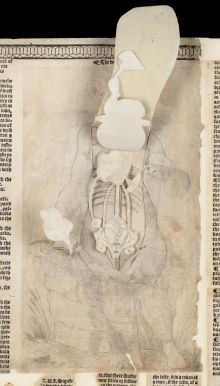Flap Anatomies - Women and Babies
Flap anatomies, also known as fugitive sheets, are three dimensional renderings of human anatomy. By using a flap or series of flaps over an image, the artist is able to create a 3D experience, as the viewer can fold back layers to reveal hidden organs, tissues, and bones. Of interest is the use of flap anatomies to illustrate female anatomy and pregnancy. This taboo subject gained particular momentum in during the Renaissance, leading to an emergence of flap anatomies "prying open the secret of women." [1] These texts demonstrate a shift towards a medicalization of pregnancy as well as a fascination with female anatomy. [2]
Female Anatomy
-

The woman [anatomical fugitive sheet]. Credit: Wellcome Collection. Attribution 4.0 International (CC BY 4.0)
Lock and Key
Some flap anatomies, particularly those displaying the female body and discussing female sexuality, were considered obscene for the time and not appropriate for a wider audience. In the period of the late 1800s, a movement advocating for sex education and anatomical understanding was popularized. In alignment with this movement, books including detailed anatomical drawings of genital anatomy, such as M. Platen's Livre D'Or De Santeì (1909) and Physicians' Anatomical Aid (1880-1890), were published, but kept under lock and key until purchased. It is debated whether the lock was purely used to encourage interest in the books or as a way to deter unsuited readers, such as young boys. [3]
Pregnancy


References
- ↑ “Anatomy.” Duke University Libraries , exhibits.library.duke.edu/exhibits/show/anatomy/anatomy/intro
- ↑ “Anatomy.” Duke University Libraries , exhibits.library.duke.edu/exhibits/show/anatomy/anatomy/intro
- ↑ “Anatomy.” Duke University Libraries , exhibits.library.duke.edu/exhibits/show/anatomy/anatomy/intro